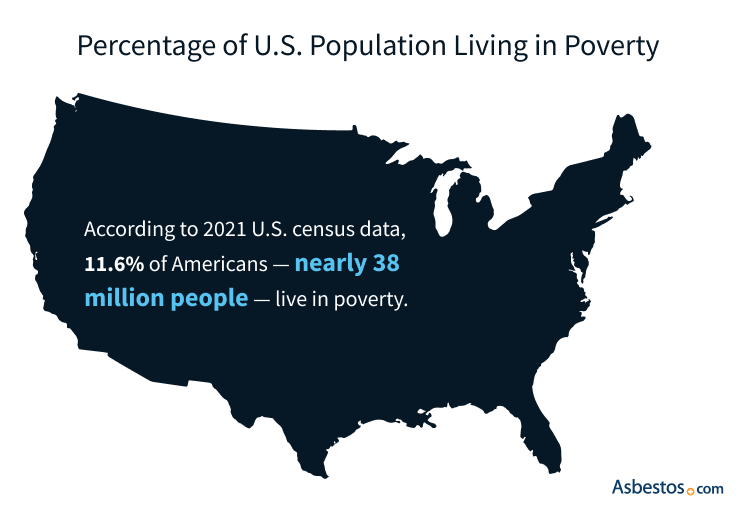Based on Your Reading:
Get Your Free Mesothelioma Guide

Find a Top Mesothelioma Doctor

Access Help Paying for Treatment

Health care in America is expensive, placing an enormous financial burden on people with cancer and other serious diseases. For low-income individuals, this produces inequalities in access to care and health outcomes. Here is what you need to know about how to cope with cancer and low income.

Written by Dr. Kristopher Bunting | Edited By Walter Pacheco | Last Update: June 26, 2024
Socioeconomic factors affect more than just income and poverty; lower socioeconomic status can lead to worse health outcomes. Living in high-poverty, low-income areas has been shown to lead to health inequities, including higher rates of cancer.
Research has also shown that lower socioeconomic status decreases cancer survival rates, including survival rates for pleural mesothelioma.
While the causes of these health inequities are not fully understood, access to care plays a role. Cancer is expensive. Economic barriers can limit the ability to travel to receive cancer care and pay for medications. People with low income and cancer can have a harder time affording the high cost of cancer treatment, keeping them from getting the care they need when they need it.
Income can affect when and where people seek medical care. People without health insurance or primary care are more likely to go to the emergency room for medical care.
Research shows that people diagnosed with cancer during an emergency department visit, or within 6 months of an ER visit, were three times more likely to die from cancer. Poor access to care can also delay cancer diagnosis, resulting in diagnosis at later stages with a worse prognosis.
Poverty can make cancer more deadly. According to 2021 U.S. census data, 11.6% of Americans — nearly 38 million people — live in poverty. Research shows that U.S. counties with high poverty rates have a higher rate of cancer death.
According to researchers, people living in high-poverty areas are less likely to have health insurance, less likely to have cancer surgery, and more likely to die from cancer. Studies of lower-income countries show that lack of access to medical resources results in higher rates of complications and death immediately after cancer surgery.

One study found that people living in high-poverty areas had more advanced stages of lung cancer, breast cancer, and colorectal cancer at the time of diagnosis. They were also less likely to have cancer surgery and more likely to die from cancer, especially those with stage 4 lung cancer. Another study found that low-income cancer survivors were more likely to have worse overall physical and mental health in addition to being less likely to have health insurance or access to medical care.
There are many reasons why poverty may worsen cancer outcomes. Those who are uninsured or do not have primary care simply do not go to the doctor as often. When they do seek care, it is often emergency care. Receiving regular, consistent medical care and routine laboratory tests can catch cancer at earlier stages, decreasing the risk of metastatic cancer and cancer-related death.
Fortunately, free or low-cost health care is available for many low-income individuals and families. Some federal, state, and local government agencies, as well as charitable organizations, work to provide health care for the uninsured and underinsured.
Veterans Affairs Administration
Veterans Affairs hospitals and clinics provide free or low-cost medical care and medications for active-duty veterans who have service-connected disabilities or financial need. The VA also has several centers across the country that specialize in emerging mesothelioma treatment.
National Association of Free and Charitable Clinics
The National Association of Free and Charitable Clinics helps people find medical clinics and pharmacies in their area. They work to ensure that uninsured and underinsured people have access to health care.
Department of Health and Human Services
The HHS Health Resources Services Administration has community-based clinics across the U.S. that provide health care services on a sliding fee scale based on financial need. The HHS also runs the HealthCare.gov Marketplace that offers health insurance that is partially subsidized based on income.
Get Your Free Mesothelioma Guide

Find a Top Mesothelioma Doctor

Access Help Paying for Treatment

There are many types of public and private financial assistance available to people living with mesothelioma and their families. Sorting through long lists of eligibility criteria and applying to different programs can be difficult and time consuming. Asbestos.com aims to help survivors and their families through this process.
There are many agencies and organizations that work to help provide direct financial assistance to low-income families as well as free or affordable health care. Asbestos.com can help find financial aid for cancer patients and their families living with mesothelioma.
In addition to the financial impact of cancer treatment, mesothelioma diagnosis and treatment can have a heavy emotional toll. Finding proper emotional support is an important part of your mesothelioma journey — it can be as important as finding the right mesothelioma doctor and treatment options.
Support groups are an essential form of emotional support that help individuals and families cope with cancer. You can learn from others’ experiences and share firsthand information and tips for living with cancer. It can help to find people with the same type of cancer who are experiencing the same symptoms, treatments, and hardships. Many support groups offer online or virtual meetings in addition to in-person meetings.
Let Asbestos.com help you find the emotional support you need. Asbestos.com provides information and resources for emotional support for mesothelioma. You can also join our exclusive mesothelioma support group at Asbestos.com or the mesothelioma Facebook support group.

Free online support group helps patients and families cope with the emotional effects of mesothelioma.
Sign Up NowThe American Cancer Society Road to Recovery program helps individuals find transportation to cancer-related medical appointments. They coordinate rides for patients with volunteers. The Cancer Financial Assistance Coalition helps cancer patients and their families find financial assistance, transportation, lodging and other services.
Food assistance can be important for low-income individuals and families. Groups such as Meals on Wheels can provide daily meals for seniors and others who need regular assistance getting proper nutrition. Feeding America is a nationwide network of food banks, food pantries, and meal programs designed to help ensure that low-income families and families in need have access to food.
Health care inequality and inequity hurt everyone. Health inequities result in higher health care costs — hundreds of billions of dollars annually. Treating cancer is expensive. Cancer prevention, early detection, and early treatment are not only cost-effective, they improve health outcomes. Cancer survivability can be increased while also lowering overall medical costs.
The problem is clear, but the solution is not. There are several ways to lower the cost of medical treatment, including increasing the transparency of medical costs, increasing competition in the medical market, and limiting the prices that health care providers can charge for care. An analysis published by the Congressional Budget Office shows that price transparency and market competition can help reduce costs to insurers, but not as much as capping health care prices. This approach has worked for Medicare, which has a set price list of what it will reimburse for various types of medical care. Health care is a huge industry, but increased government regulation may lower costs and improve health outcomes.
Recommended ReadingThank you for your feedback. Would you like to speak with a Patient Advocate?
Your web browser is no longer supported by Microsoft. Update your browser for more security, speed and compatibility.
If you are looking for mesothelioma support, please contact our Patient Advocates at (855) 404-4592
The Mesothelioma Center at Asbestos.com has provided patients and their loved ones the most updated and reliable information on mesothelioma and asbestos exposure since 2006.
Our team of Patient Advocates includes a medical doctor, a registered nurse, health services administrators, veterans, VA-accredited Claims Agents, an oncology patient navigator and hospice care expert. Their combined expertise means we help any mesothelioma patient or loved one through every step of their cancer journey.
More than 30 contributors, including mesothelioma doctors, survivors, health care professionals and other experts, have peer-reviewed our website and written unique research-driven articles to ensure you get the highest-quality medical and health information.
My family has only the highest compliment for the assistance and support that we received from The Mesothelioma Center. This is a staff of compassionate and knowledgeable individuals who respect what your family is experiencing and who go the extra mile to make an unfortunate diagnosis less stressful. Information and assistance were provided by The Mesothelioma Center at no cost to our family.LashawnMesothelioma patient’s daughter


Bunting, K. (2024, June 26). Guide to Cancer with Low Income. Asbestos.com. Retrieved July 26, 2024, from https://www.asbestos.com/cancer/low-income/
Bunting, Kristopher. "Guide to Cancer with Low Income." Asbestos.com, 26 Jun 2024, https://www.asbestos.com/cancer/low-income/.
Bunting, Kristopher. "Guide to Cancer with Low Income." Asbestos.com. Last modified June 26, 2024. https://www.asbestos.com/cancer/low-income/.
The Mesothelioma Center at Asbestos.com has provided patients and their loved ones the most updated and reliable information on mesothelioma and asbestos exposure since 2006.
Our team of Patient Advocates includes a medical doctor, a registered nurse, health services administrators, veterans, VA-accredited Claims Agents, an oncology patient navigator and hospice care expert. Their combined expertise means we help any mesothelioma patient or loved one through every step of their cancer journey.
More than 30 contributors, including mesothelioma doctors, survivors, health care professionals and other experts, have peer-reviewed our website and written unique research-driven articles to ensure you get the highest-quality medical and health information.
My family has only the highest compliment for the assistance and support that we received from The Mesothelioma Center. This is a staff of compassionate and knowledgeable individuals who respect what your family is experiencing and who go the extra mile to make an unfortunate diagnosis less stressful. Information and assistance were provided by The Mesothelioma Center at no cost to our family.LashawnMesothelioma patient’s daughter


Bunting, K. (2024, June 26). Guide to Cancer with Low Income. Asbestos.com. Retrieved July 26, 2024, from https://www.asbestos.com/cancer/low-income/
Bunting, Kristopher. "Guide to Cancer with Low Income." Asbestos.com, 26 Jun 2024, https://www.asbestos.com/cancer/low-income/.
Bunting, Kristopher. "Guide to Cancer with Low Income." Asbestos.com. Last modified June 26, 2024. https://www.asbestos.com/cancer/low-income/.
The Mesothelioma Center at Asbestos.com has provided patients and their loved ones the most updated and reliable information on mesothelioma and asbestos exposure since 2006.
Our team of Patient Advocates includes a medical doctor, a registered nurse, health services administrators, veterans, VA-accredited Claims Agents, an oncology patient navigator and hospice care expert. Their combined expertise means we help any mesothelioma patient or loved one through every step of their cancer journey.
More than 30 contributors, including mesothelioma doctors, survivors, health care professionals and other experts, have peer-reviewed our website and written unique research-driven articles to ensure you get the highest-quality medical and health information.
My family has only the highest compliment for the assistance and support that we received from The Mesothelioma Center. This is a staff of compassionate and knowledgeable individuals who respect what your family is experiencing and who go the extra mile to make an unfortunate diagnosis less stressful. Information and assistance were provided by The Mesothelioma Center at no cost to our family.LashawnMesothelioma patient’s daughter


Bunting, K. (2024, June 26). Guide to Cancer with Low Income. Asbestos.com. Retrieved July 26, 2024, from https://www.asbestos.com/cancer/low-income/
Bunting, Kristopher. "Guide to Cancer with Low Income." Asbestos.com, 26 Jun 2024, https://www.asbestos.com/cancer/low-income/.
Bunting, Kristopher. "Guide to Cancer with Low Income." Asbestos.com. Last modified June 26, 2024. https://www.asbestos.com/cancer/low-income/.
The Mesothelioma Center at Asbestos.com has provided patients and their loved ones the most updated and reliable information on mesothelioma and asbestos exposure since 2006.
Our team of Patient Advocates includes a medical doctor, a registered nurse, health services administrators, veterans, VA-accredited Claims Agents, an oncology patient navigator and hospice care expert. Their combined expertise means we help any mesothelioma patient or loved one through every step of their cancer journey.
More than 30 contributors, including mesothelioma doctors, survivors, health care professionals and other experts, have peer-reviewed our website and written unique research-driven articles to ensure you get the highest-quality medical and health information.
My family has only the highest compliment for the assistance and support that we received from The Mesothelioma Center. This is a staff of compassionate and knowledgeable individuals who respect what your family is experiencing and who go the extra mile to make an unfortunate diagnosis less stressful. Information and assistance were provided by The Mesothelioma Center at no cost to our family.LashawnMesothelioma patient’s daughter


Bunting, K. (2024, June 26). Guide to Cancer with Low Income. Asbestos.com. Retrieved July 26, 2024, from https://www.asbestos.com/cancer/low-income/
Bunting, Kristopher. "Guide to Cancer with Low Income." Asbestos.com, 26 Jun 2024, https://www.asbestos.com/cancer/low-income/.
Bunting, Kristopher. "Guide to Cancer with Low Income." Asbestos.com. Last modified June 26, 2024. https://www.asbestos.com/cancer/low-income/.
The Mesothelioma Center at Asbestos.com has provided patients and their loved ones the most updated and reliable information on mesothelioma and asbestos exposure since 2006.
Our team of Patient Advocates includes a medical doctor, a registered nurse, health services administrators, veterans, VA-accredited Claims Agents, an oncology patient navigator and hospice care expert. Their combined expertise means we help any mesothelioma patient or loved one through every step of their cancer journey.
More than 30 contributors, including mesothelioma doctors, survivors, health care professionals and other experts, have peer-reviewed our website and written unique research-driven articles to ensure you get the highest-quality medical and health information.
My family has only the highest compliment for the assistance and support that we received from The Mesothelioma Center. This is a staff of compassionate and knowledgeable individuals who respect what your family is experiencing and who go the extra mile to make an unfortunate diagnosis less stressful. Information and assistance were provided by The Mesothelioma Center at no cost to our family.LashawnMesothelioma patient’s daughter


Bunting, K. (2024, June 26). Guide to Cancer with Low Income. Asbestos.com. Retrieved July 26, 2024, from https://www.asbestos.com/cancer/low-income/
Bunting, Kristopher. "Guide to Cancer with Low Income." Asbestos.com, 26 Jun 2024, https://www.asbestos.com/cancer/low-income/.
Bunting, Kristopher. "Guide to Cancer with Low Income." Asbestos.com. Last modified June 26, 2024. https://www.asbestos.com/cancer/low-income/.
The Mesothelioma Center at Asbestos.com has provided patients and their loved ones the most updated and reliable information on mesothelioma and asbestos exposure since 2006.
Our team of Patient Advocates includes a medical doctor, a registered nurse, health services administrators, veterans, VA-accredited Claims Agents, an oncology patient navigator and hospice care expert. Their combined expertise means we help any mesothelioma patient or loved one through every step of their cancer journey.
More than 30 contributors, including mesothelioma doctors, survivors, health care professionals and other experts, have peer-reviewed our website and written unique research-driven articles to ensure you get the highest-quality medical and health information.
My family has only the highest compliment for the assistance and support that we received from The Mesothelioma Center. This is a staff of compassionate and knowledgeable individuals who respect what your family is experiencing and who go the extra mile to make an unfortunate diagnosis less stressful. Information and assistance were provided by The Mesothelioma Center at no cost to our family.LashawnMesothelioma patient’s daughter


Bunting, K. (2024, June 26). Guide to Cancer with Low Income. Asbestos.com. Retrieved July 26, 2024, from https://www.asbestos.com/cancer/low-income/
Bunting, Kristopher. "Guide to Cancer with Low Income." Asbestos.com, 26 Jun 2024, https://www.asbestos.com/cancer/low-income/.
Bunting, Kristopher. "Guide to Cancer with Low Income." Asbestos.com. Last modified June 26, 2024. https://www.asbestos.com/cancer/low-income/.
The Mesothelioma Center at Asbestos.com has provided patients and their loved ones the most updated and reliable information on mesothelioma and asbestos exposure since 2006.
Our team of Patient Advocates includes a medical doctor, a registered nurse, health services administrators, veterans, VA-accredited Claims Agents, an oncology patient navigator and hospice care expert. Their combined expertise means we help any mesothelioma patient or loved one through every step of their cancer journey.
More than 30 contributors, including mesothelioma doctors, survivors, health care professionals and other experts, have peer-reviewed our website and written unique research-driven articles to ensure you get the highest-quality medical and health information.
My family has only the highest compliment for the assistance and support that we received from The Mesothelioma Center. This is a staff of compassionate and knowledgeable individuals who respect what your family is experiencing and who go the extra mile to make an unfortunate diagnosis less stressful. Information and assistance were provided by The Mesothelioma Center at no cost to our family.LashawnMesothelioma patient’s daughter


Bunting, K. (2024, June 26). Guide to Cancer with Low Income. Asbestos.com. Retrieved July 26, 2024, from https://www.asbestos.com/cancer/low-income/
Bunting, Kristopher. "Guide to Cancer with Low Income." Asbestos.com, 26 Jun 2024, https://www.asbestos.com/cancer/low-income/.
Bunting, Kristopher. "Guide to Cancer with Low Income." Asbestos.com. Last modified June 26, 2024. https://www.asbestos.com/cancer/low-income/.
The Mesothelioma Center at Asbestos.com has provided patients and their loved ones the most updated and reliable information on mesothelioma and asbestos exposure since 2006.
Our team of Patient Advocates includes a medical doctor, a registered nurse, health services administrators, veterans, VA-accredited Claims Agents, an oncology patient navigator and hospice care expert. Their combined expertise means we help any mesothelioma patient or loved one through every step of their cancer journey.
More than 30 contributors, including mesothelioma doctors, survivors, health care professionals and other experts, have peer-reviewed our website and written unique research-driven articles to ensure you get the highest-quality medical and health information.
My family has only the highest compliment for the assistance and support that we received from The Mesothelioma Center. This is a staff of compassionate and knowledgeable individuals who respect what your family is experiencing and who go the extra mile to make an unfortunate diagnosis less stressful. Information and assistance were provided by The Mesothelioma Center at no cost to our family.LashawnMesothelioma patient’s daughter


Bunting, K. (2024, June 26). Guide to Cancer with Low Income. Asbestos.com. Retrieved July 26, 2024, from https://www.asbestos.com/cancer/low-income/
Bunting, Kristopher. "Guide to Cancer with Low Income." Asbestos.com, 26 Jun 2024, https://www.asbestos.com/cancer/low-income/.
Bunting, Kristopher. "Guide to Cancer with Low Income." Asbestos.com. Last modified June 26, 2024. https://www.asbestos.com/cancer/low-income/.
The Mesothelioma Center at Asbestos.com has provided patients and their loved ones the most updated and reliable information on mesothelioma and asbestos exposure since 2006.
Our team of Patient Advocates includes a medical doctor, a registered nurse, health services administrators, veterans, VA-accredited Claims Agents, an oncology patient navigator and hospice care expert. Their combined expertise means we help any mesothelioma patient or loved one through every step of their cancer journey.
More than 30 contributors, including mesothelioma doctors, survivors, health care professionals and other experts, have peer-reviewed our website and written unique research-driven articles to ensure you get the highest-quality medical and health information.
My family has only the highest compliment for the assistance and support that we received from The Mesothelioma Center. This is a staff of compassionate and knowledgeable individuals who respect what your family is experiencing and who go the extra mile to make an unfortunate diagnosis less stressful. Information and assistance were provided by The Mesothelioma Center at no cost to our family.LashawnMesothelioma patient’s daughter


Bunting, K. (2024, June 26). Guide to Cancer with Low Income. Asbestos.com. Retrieved July 26, 2024, from https://www.asbestos.com/cancer/low-income/
Bunting, Kristopher. "Guide to Cancer with Low Income." Asbestos.com, 26 Jun 2024, https://www.asbestos.com/cancer/low-income/.
Bunting, Kristopher. "Guide to Cancer with Low Income." Asbestos.com. Last modified June 26, 2024. https://www.asbestos.com/cancer/low-income/.
The Mesothelioma Center at Asbestos.com has provided patients and their loved ones the most updated and reliable information on mesothelioma and asbestos exposure since 2006.
Our team of Patient Advocates includes a medical doctor, a registered nurse, health services administrators, veterans, VA-accredited Claims Agents, an oncology patient navigator and hospice care expert. Their combined expertise means we help any mesothelioma patient or loved one through every step of their cancer journey.
More than 30 contributors, including mesothelioma doctors, survivors, health care professionals and other experts, have peer-reviewed our website and written unique research-driven articles to ensure you get the highest-quality medical and health information.
My family has only the highest compliment for the assistance and support that we received from The Mesothelioma Center. This is a staff of compassionate and knowledgeable individuals who respect what your family is experiencing and who go the extra mile to make an unfortunate diagnosis less stressful. Information and assistance were provided by The Mesothelioma Center at no cost to our family.LashawnMesothelioma patient’s daughter


Bunting, K. (2024, June 26). Guide to Cancer with Low Income. Asbestos.com. Retrieved July 26, 2024, from https://www.asbestos.com/cancer/low-income/
Bunting, Kristopher. "Guide to Cancer with Low Income." Asbestos.com, 26 Jun 2024, https://www.asbestos.com/cancer/low-income/.
Bunting, Kristopher. "Guide to Cancer with Low Income." Asbestos.com. Last modified June 26, 2024. https://www.asbestos.com/cancer/low-income/.
Mesothelioma Center - Vital Services for Cancer Patients & Families doesn’t believe in selling customer information. However, as required by the new California Consumer Privacy Act (CCPA), you may record your preference to view or remove your personal information by completing the form below.
